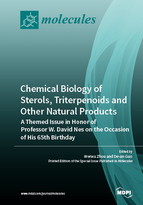Chemical Biology of Sterols, Triterpenoids and Other Natural Products: A Themed Issue in Honor of Professor W. David Nes on the Occasion of His 65th Birthday
A special issue of Molecules (ISSN 1420-3049). This special issue belongs to the section "Natural Products Chemistry".
Deadline for manuscript submissions: closed (1 October 2018) | Viewed by 87100
Special Issue Editors
Interests: sterol; antifungal; sterol biosynthesis; sterol auxotrophy; metabolomics
Interests: active ingredients of traditionnal chinese medicines; quality standards of traditionnal chinese medicines; biotransformation of natural products
Special Issues, Collections and Topics in MDPI journals
Special Issue Information
Dear Colleagues,
Dr. W. David Nes is an eminent sterol biochemist who has made seminal contributions to the areas of chemical analysis, biosynthesis, and mechanistic enzymology. His fundamental research has led to the isolation and synthesis of over 300 sterols and triterpenoids, to a greater understanding of sterol diversity and function across kingdoms, and new knowledge for catalytic competence and three-dimensional structures of sterol biosynthesis enzymes. He developed significant collaborations in the US and abroad to advance steroidal inhibitors for the treatment of fungal and protozoan diseases. Dr. W. David Nes is currently a Paul Whitfield Horn Professor of Chemistry & Biochemistry at Texas Tech University, Lubbock, Texas. He received his BA from Gettysburg College (1975), MS from Drexel University (1977), and PhD from the University of Maryland, College Park (1979). He completed post-doctoral studies at the University of California, Berkeley and at the ARS-USDA regional laboratory in Albany CA during years 1979 to 1982. He continued on in the Plant Physiology and Chemistry Research Unit in Albany and then in the Microbial Products Research Unit at the USDA laboratory in Athens, GA until 1993 as Lead Research Chemist. In 1993, he moved to the Department of Chemistry & Biochemistry and was promoted to Horn professor in 2007. From 1999 to 2016, he was Division Chair of Biochemistry, and from 2012 to 2016, Director of the Center for Chemical Biology at Texas Tech University. He took a two-year leave of absence from the university during the period 2003–2005 to be Program Director of Molecular Biochemistry in the Division of Molecular and Cellular Biosciences at the National Science Foundation.
Professor Nes has received several awards for research excellence while at the USDA and at Texas Tech University, including the Barnie E. Rushing Jr. Award for Research Excellence. He has received an Honorable Guest Professorship (Peking University, China, 1995), Advanced Distinguished Lectureship (Kansas State University, 2010), DAAD fellowship from Germany (1982), and was sponsored by several members of the National Academy of Sciences and Royal Society to publish papers in PNAS and Proc. R. Soc. and contributed papers to special issues honoring members of the US National Academy of Sciences. During his career, he has held adjunct professor positions in the chemistry department at Auburn University (1988–1993) and the Natural Product Institute at the University of Georgia (1991–1993). He has held Visiting Professorships at the Institute for Chemical Ecology (Max Planck Institute, Jena, Germany 2007) and Centre for Cytochrome P-450 Biodiversity (College of Medicine, Swansea University, Wales, 2013) and Professorship in the Department of Immunology and Molecular Microbiology (Texas Tech Health Sciences Center School of Medicine, 2013–2017) and has served on the editorial boards of high-impact journals and on a range of federal panels, including the National Institutes of Health and National Science Foundation. He has been funded by USDA, NIH, NSF, Welch Foundation and Industry, including AstraZeneca Pharmaceuticals, Norvatis, Monsanto, and Bayer Crops, and mentored 30 MS and PhD students and 43 Post-doctoral fellows and Visiting Scientists. His high H-index is reflective of his >200 publications and eight books, many of which are among some of the highly cited or considered classics.
Molecules is highly pleased to host a Special Issue, and invites scientists to submit original contributions to “Chemical Biology of Sterols, Triterpenoids and Other Natural Products: A Themed Issue in Honor of Professor W. David Nes on the Occasion of His 65th Birthday”.
Assoc. Prof. Dr. Wenxu ZhouProf. Dr. De-an Guo
Guest Editors
Manuscript Submission Information
Manuscripts should be submitted online at www.mdpi.com by registering and logging in to this website. Once you are registered, click here to go to the submission form. Manuscripts can be submitted until the deadline. All submissions that pass pre-check are peer-reviewed. Accepted papers will be published continuously in the journal (as soon as accepted) and will be listed together on the special issue website. Research articles, review articles as well as short communications are invited. For planned papers, a title and short abstract (about 100 words) can be sent to the Editorial Office for announcement on this website.
Submitted manuscripts should not have been published previously, nor be under consideration for publication elsewhere (except conference proceedings papers). All manuscripts are thoroughly refereed through a single-blind peer-review process. A guide for authors and other relevant information for submission of manuscripts is available on the Instructions for Authors page. Molecules is an international peer-reviewed open access semimonthly journal published by MDPI.
Please visit the Instructions for Authors page before submitting a manuscript. The Article Processing Charge (APC) for publication in this open access journal is 2700 CHF (Swiss Francs). Submitted papers should be well formatted and use good English. Authors may use MDPI's English editing service prior to publication or during author revisions.
Keywords
- sterol
- sterol biosynthesis
- natural products
- isoprenoids
- cholesterol
- phytosterol
- lipidomics
- enzymology/enzyme mechanisms
- ergosterol biosynthesis inhibitors
- drug therapy
- CYP51
- sterol C24-methyltransferase
- suicide substrate
- transition state analog
- antifungal
- anti-parasite drugs
- sparking function
- chemical analysis
- eukaryotic pathogen
- sterol evolution
- sterol auxotroph








